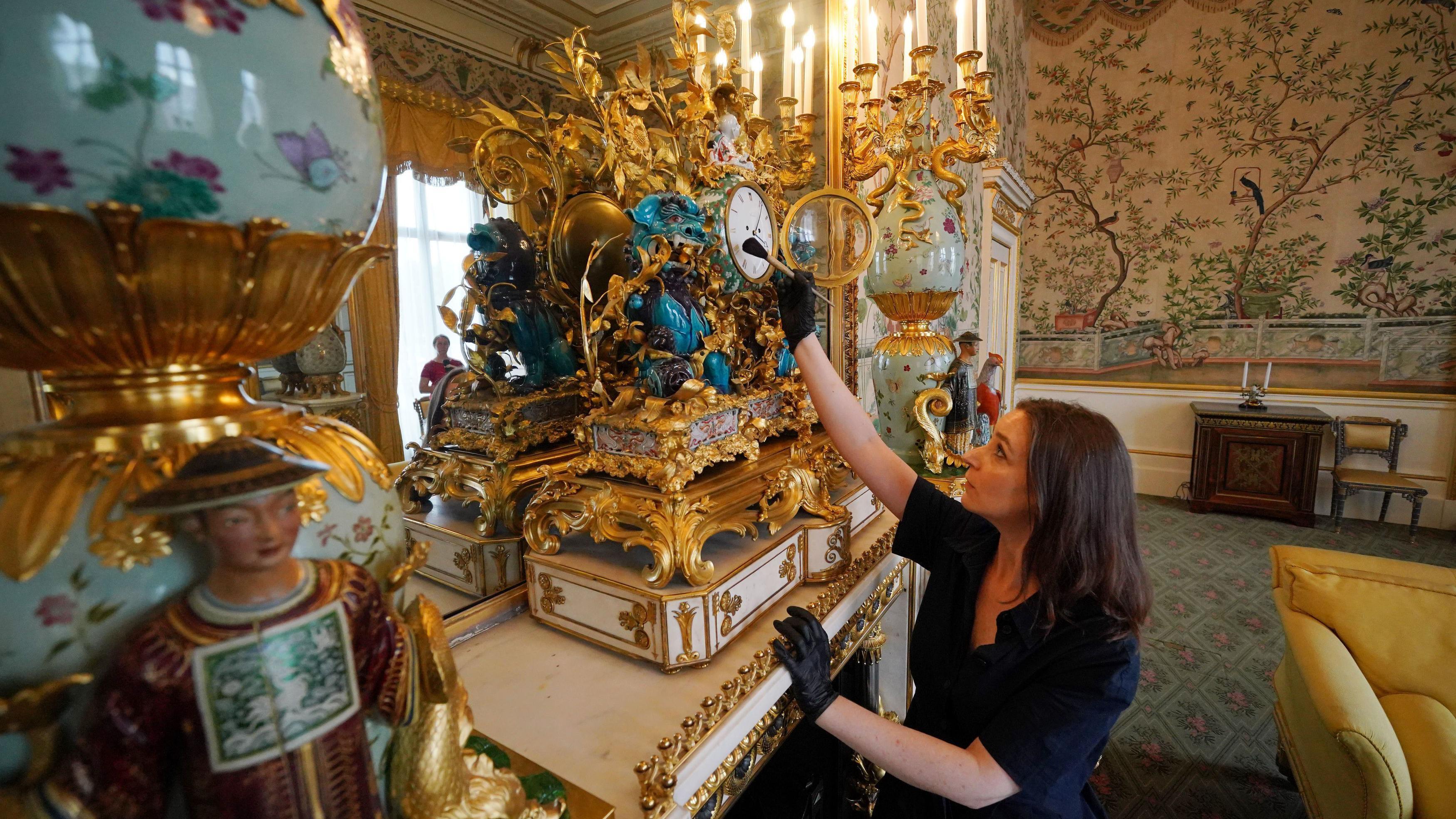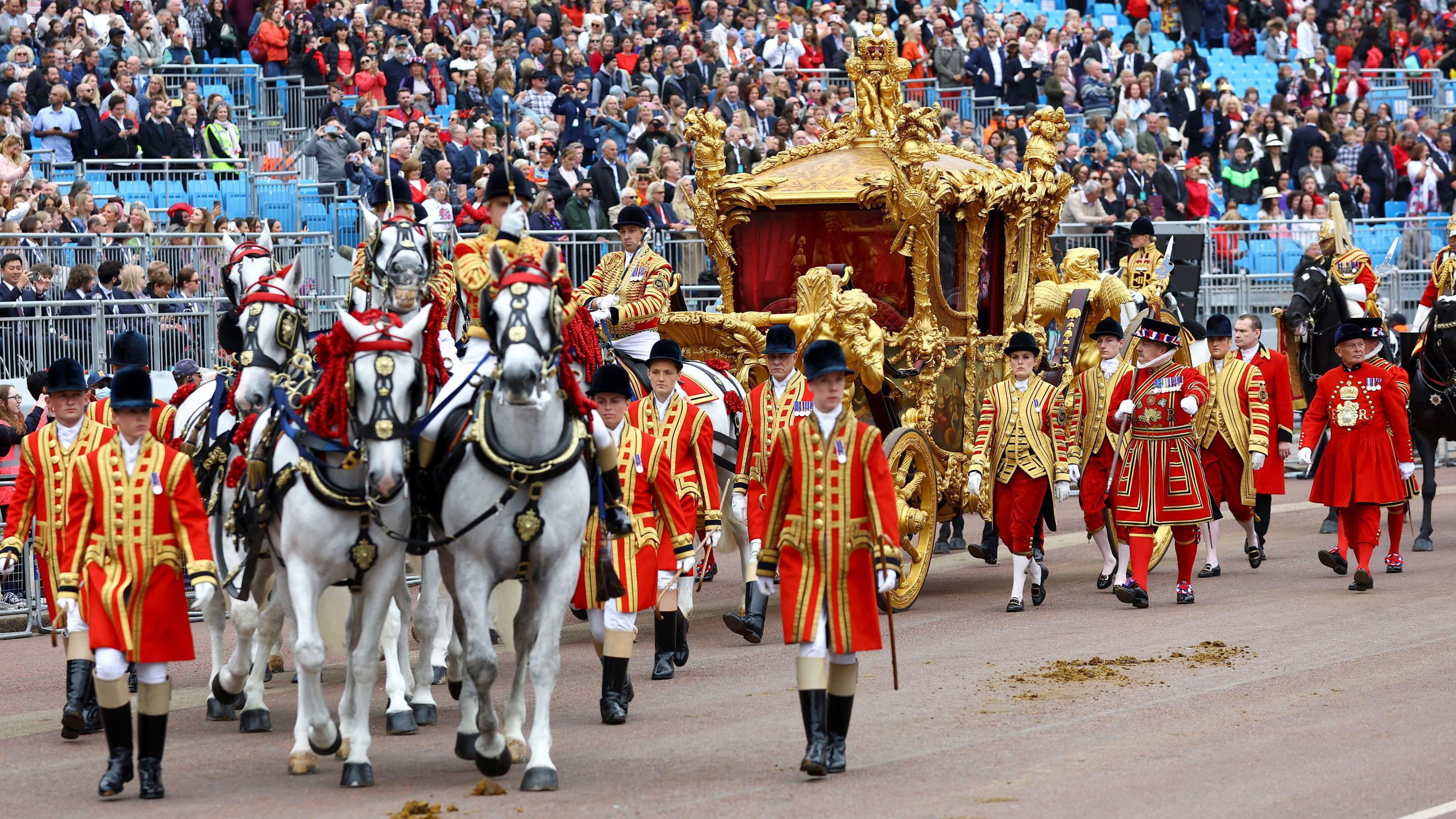Official data reveals that public funding for the Royal Household has increased threefold in real value since 2012, primarily due to repair and construction activities at Buckingham Palace.
The Sovereign Grant, which offers financial backing from taxpayers for the monarchy, was initiated in 2012 with an annual amount of £31 million. According to information provided by the House of Commons Library, this grant has surged to £132 million today. Adjusting for inflation reveals that this figure marks approximately a tripling of funds since its inception.
In April, the grant increased by 53%, rising from £86.3 million to £132.1 million. According to royal officials, this rise can be attributed to a refurbishment project at Buckingham Palace, with assurances that the grant amount will decrease again in the future. They also emphasize that the monarchy offers excellent value for money.
Lord Turnbull, a crossbencher and ex-Cabinet Secretary, described the methodology used for calculating the grant as “absolute foolishness,” yet he noted that the anggaran is modest when contrasted with those of other presidents’ heads of state.
The Sovereign Grant funds the official responsibilities of the monarchy. For the fiscal year 2023-24, the largest expenditures included property upkeep and employee salaries, along with lesser sums allocated for transportation, entertainment, and household management costs.
According to the analysis conducted by the House of Commons Library, this chart illustrates the increase in the Sovereign Grant over the years when adjusted for inflation, with all figures standardized to reflect 2023-24 value benchmarks for comparison purposes.
With this metric, the Sovereign Grant amounted to £41.5 million in 2012-13 — increasing to nearly £100 million in 2018-19 to fund palace refurbishments. It further escalated to £129.3 million in 2025-26, once more intended for repairs at Buckingham Palace.
A Bank of England inflation calculation also shows the grant’s value having trebled since 2012, although Buckingham Palace uses a separate figure which is slightly below a threefold real-terms increase.
Buckingham Palace states that the present costs are elevated due to a £369 million, ten-year initiative aimed at updating the palace’s infrastructure. This includes improvements to electrical systems, plumbing, wiring, and elevators. The National Audit Office considers this project to be efficiently managed and notes that it provides good value for money.
The Palace claims that comparing this year’s figures with previous years’ grant amounts is misleading. According to them, the significant rise is attributed to funding allocated specifically for refurbishing the Buckingham Palace structure, not because of an escalation in what they consider as regular operational expenses under their core grant.
“The Sovereign Grant remained virtually flat for five years from 2020, during a period of high inflation. The majority of the increase in this year’s Sovereign Grant is to fund the Buckingham Palace Reservicing Programme, which is ensuring that the Palace, a national asset, is accessible and protected from fire and flood,” said a Palace spokesperson.
“A provisional boost in the grant over two years was authorized to cover the remaining funds agreed upon in 2016 for this resurfacing effort. The expectation has consistently been that the amount of the Sovereign Grant would decrease after the completion of the project,” stated the spokesperson.
This might result in reduced taxpayer funding post-2027.

The significant rise observed over the last ten years occurred amidst challenging times for public finance management, characterized by phases of fiscal restraint and stringent budgetary restrictions.
A report from the Institute for Fiscal Studies indicated that public expenditure on education in England decreased by 11% in real terms from 2010-11 to 2023-24. However, the IFS notes that comparing substantial multi-billion-pound budgets like these can be challenging when measured against variations in comparatively modest sums, such as the Sovereign Grant.
Prior to the introduction of the Sovereign Grant, financial support for the monarchy from the state was provided through various means including different grants, expenditures by government departments, and what was known as a “civil list” payment.
Data provided by the House of Commons Library, dating back to 1995, indicates that the amounts prior to the Sovereign Grant were less than current figures. For example, based on 2023-24 estimates, these sums amounted to £67 million in 2000 and £56 million in 2005.
The Sovereign Grant was established as a more “contemporary and open” method for consolidating royal finances. It was presented to Members of Parliament in 2011 with the expectation that it might decrease the amount of money going into the monarchy.
The grant is determined as a percentage of the profits generated by the independent property and land management company known as the Crown Estate. Although this funding does not originate directly from the Crown Estate, it is sourced from the Treasury; however, the performance of the Crown Estate serves as a point of reference for setting the amount.
The Sovereign Grant was originally established at 15% of the profits from the Crown Estate but increased to 25% to accommodate the expenses related to refurbishing Buckingham Palace.
The rate is now being lowered to 12%, but due to higher earnings for the Crown Estate from leasing offshore wind farm sites, the actual monetary amount has surged significantly. This increase stems from applying this lower percentage to a substantially larger overall sum.
Norman Baker, a previous Liberal Democrat Home Office minister and a notable detractor of royal finance matters, attributes the rise in the Sovereign Grant’s value to two factors: firstly, what he deems as an “entirely preposterous” method of calculation; secondly, ‘timid’ administrations reluctant to contest this increase.
He states, ‘The Royal Family has been quite adept at convincing the government to continue providing additional funds from public resources.’
Buckingham Palace has repeatedly been used to support the raises.
It’s often said that our public funds are limited and we cannot afford a winter fuel allowance, yet at the same time, we find money for raises within the royal household. This seems entirely incorrect.

Lord Turnbull, who served as both a Cabinet Secretary and Permanent Secretary at the Treasury during the 1990s and 2000s, expresses disapproval of how the grant is determined. He argues that various administrations have relied on the Crown Estate calculations simply because it sidesteps discussion and prevents “a lot of assertive members from complaining about the expense of maintaining the monarchy.”
He suggests it would be far more preferable to have a direct grant allocated specifically for supporting the monarchy, allowing discussions focused on its inherent value.
However, he also argues that concentrating solely on the rise in the Sovereign Grant is a “distraction.” This increase can largely be attributed to efforts aimed at restoring Buckingham Palace, not due to increased everyday expenses. According to him, maintaining the monarchy requires adequate funding. As Lord Turnbull puts it, “It’s an all-or-nothing situation with the monarchy; you must fund it appropriately or do away with it entirely.”
Pauline Maclaran, a royal observer from Royal Holloway, University of London, states that the monarchy “brings in substantial funds and positive public sentiment.”
This is frequently viewed through the lens of enhancing tourism and fostering business connections; however, Professor Maclaran argues that it now also has to acknowledge the influence of royal “soft power.”
U.S. President Donald Trump has expressed his admiration for King Charles, and if these positive sentiments facilitated better trade and tariff discussions between the United Kingdom and the U.S., the advantages would far surpass the yearly expenses associated with maintaining the monarchy, according to Professor Maclaran.

But the royals can’t be immune to questions about finances, she says: “The public wants to know if they’re of value.”
A royal expert named Richard Palmer indicates that this year’s rise has “caused surprise.”
As Mr Palmer points out, it’s clear that funding should go not only to the head of state and their supporters, but also to crucial sectors like healthcare, education, and the armed forces.
According to royal insiders, everything is conducted with openness, and financial support hinges upon parliamentary consent. The grant is managed by three Royal Trustees: the Prime Minister, the Chancellor, and the Keeper of the Privy Purse, responsible for handling the sovereign’s monetary affairs.
You can explore the financial records and observe that starting from 2023-24, the royal family expended over £1 million on helicopter trips. Additionally, their electricity expenses amounted to £2.2 million. It’s also noteworthy that transportation costs for the Duke of Kent across three days to participate in military gatherings in Scotland surpassed £23,000.
The report includes information about what the monarchy contributes annually, such as organizing around 400 events, welcoming approximately 105,000 visitors to various gatherings like receptions and garden parties, and undertaking roughly 2,300 public appearances. These efforts help support numerous charitable organizations and initiatives.
National and international occasions, like state visits, contribute to promoting UK commerce. Additionally, there is a constitutional duty encompassing events such as the State Opening of Parliament and routine meetings with the Prime Minister.
A group called Republic, which advocates for an elected leader instead of a monarch, has contended that additional expenses should be factored in, like security costs, which are not addressed by the Sovereign Grant.
They aim to classify the revenues from the Duchies of Lancaster and Cornwall as public financing instead of personal earnings for the King and the Prince of Wales. According to a report issued by the organization, the overall expense of maintaining the monarchy stands at approximately £510 million annually.
According to opinion polls, the monarchy continues to be well-regarded, as indicated by a YouGov survey conducted in February 2025 which showed that 55% of respondents had positive views about the monarchy, whereas only 36% held negative opinions.
However, the situation regarding funding is less clear-cut. A YouGov poll conducted in December 2024 indicated significant public resistance to using governmental funds for Buckingham Palace, with 56% against and 29% in favor.
Additionally, there are distinctions based on age brackets — 74% of those aged 65 and older believe that the royal family provides good value for their money, whereas only 44% of individuals between 25 and 49 years old agree with this sentiment.

Register here to receive the most recent updates on royalty and insightful analyses.
Each week through our Royal Watch newsletter. People outside the UK can
sign up here
.
- What are King Charles’ roles or responsibilities?
- Monarch conveys sincere message to other individuals battling cancer
- Harry and Meghan urge for enhanced online safeguards for kids.
- Princess Charlotte photo released to mark 10th birthday
- King and Queen to Host VE Day Tea Party for War Veterans
